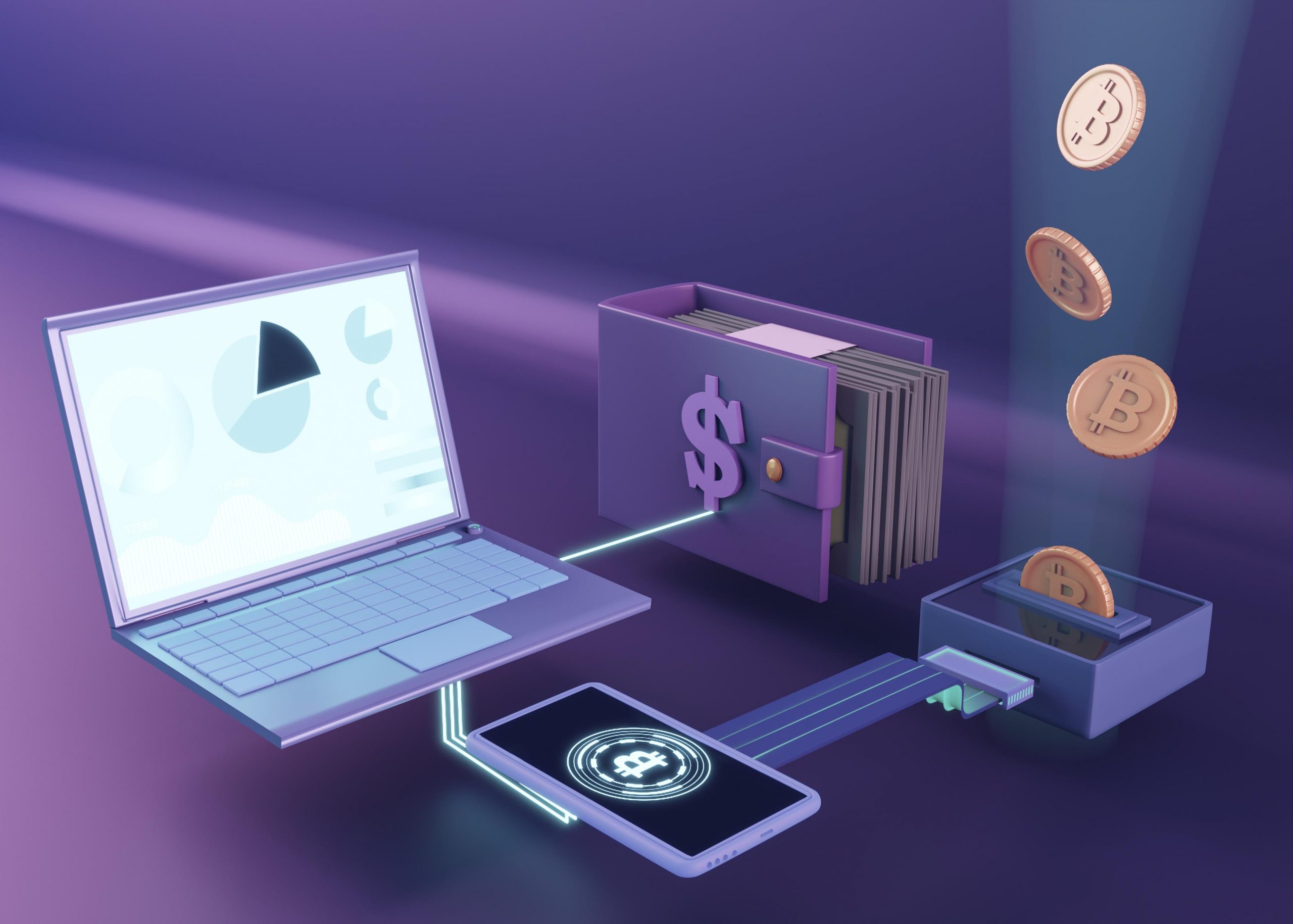Bitcoin mining is a process that helps verify bitcoin transactions and create new bitcoin. In many ways, bitcoin mining is similar to gold mining. Bitcoin mining and gold mining are both energy intensive, and both have the potential to generate a handsome monetary reward.
Let’s dig further into bitcoin mining to learn about how it works and how it influences bitcoin transactions and bitcoin investors.
What Is Bitcoin Mining?
Bitcoin mining is a highly complex computing process that uses complicated computer code to create a secure cryptographic system. Similar to the secret codes used by governments and spies, the cryptography used for mining generates bitcoin, facilitates bitcoin transactions, and tracks asset ownership of the cryptocurrency.
Bitcoin mining supports the bitcoin database, which is called the blockchain. By verifying transactions, miners help maintain the blockchain with accurate information about transaction history and the balances bitcoin users have. Maintaining the blockchain also helps prevent fraudulent transactions and activity, such as someone trying to transfer a bitcoin they don’t own.
Unlike gold miners, bitcoin miners are not people with picks and shovels, but rather owners of sophisticated computing equipment. Bitcoin miners compete to be the first to verify Bitcoin transactions and earn rewards paid in bitcoin. While anyone can mine bitcoin, because of the required computing power and energy usage, it’s tough to profit from bitcoin mining.


How Does Bitcoin Mining Work?
Bitcoin miners need to first invest in computer equipment that is specialized for mining, and typically requires access to a low-cost energy source.
Bitcoin transactions that need to be verified are parceled together in what is called a “block.” Blocks put together in an order create the blockchain, much like links of any chain. The difference here is that each block carries information about where bitcoin is coming from and where it’s going in a transaction. Therefore, the integrity and verification of each block prior to and after is as important as the verification of any given block.
Each block comes with a set of cryptographic rules (complicated mathematical functions) called a hash that miners must work to verify. These rules also make it very hard for anyone to manipulate or fraudulently add or remove blocks from the blockchain.
Hashes are used in bitcoin mining to ensure that blocks have not been manipulated and the chain of transactions is accurate. Bitcoin miners race to complete challenging mathematical functions to guess these hashes and process bitcoin transactions.
A miner’s hash rate is the speed at which the configuration of computers is able to solve the mathematical equations. This mining protocol is called proof of work because the first miner to prove that they have done the “work” of solving a complex equation earns the right to process the newest block of Bitcoin transactions. Successful miners also receive bitcoin as a reward and a transaction fee. As of June 2022, a successful miner would earn 6.25 bitcoin as a reward.
After a miner successfully verifies a new block of transactions, the block is distributed to all other miners and any other device with a full copy of the Bitcoin blockchain. (These devices are called nodes.) Many computers worldwide keep identical copies of the blockchain, ensuring the creation and maintenance of a trusted, verified history that’s nearly impossible to hack or distort.
Why Mine Bitcoin?
If you’re interested in mining bitcoin on your own, known as solo mining, and want to earn a profit, then you’ll likely need specialized mining hardware. As mentioned above, successful miners can earn 6.25 bitcoin for every block they verify, in addition to earning a transaction fee (also paid in bitcoin).
Mining with a graphics processing unit (GPU) or application-specific integrated circuit (ASIC) is generally the most effective, although computers like your laptop or desktop (which rely on a central processing unit chip to handle its basic functions) can also be used.
But is bitcoin mining profitable? That depends. For solo miners, bitcoin mining may not lead to big bucks for a number of reasons.
In addition to expensive hardware, you’ll have to consider internet bandwidth availability and your local power costs. Bitcoin mining uses a large amount of electricity. To profit, you need access to low-cost power or perhaps solar panels on your roof. You also need an internet service provider that allows unlimited internet usage without charging fees for going over a specific data limit.
There will be a limited supply of bitcoin, capped at 21 million. As of June 2022, over 19 million have already been mined. That scarcity makes bitcoin more competitive and only those with massive computing power stand a chance of success.
How To Start Mining Bitcoins?
Curious about exactly how to mine bitcoin? Bitcoin mining isn’t simple, but anyone with the right equipment and a little background knowledge can take a shot at it. If you’ve reviewed the potential and want to get started with bitcoin mining, then follow these basic steps:
Choose Your Bitcoin Mining Hardware?
Your first step is choosing the hardware you’ll use to mine bitcoin. Many people start with an old computer to get a basic idea of how bitcoin mining works. If you want to earn a profit, it’s important to use optimized mining hardware, such as a Graphics Processing Unit (GPU) or Application-Specific Integrated Circuit (ASIC) miner.
Other minimum requirements for bitcoin mining include a high-speed internet connection of at least 50 kilobytes per second, plus no restrictions on data uploads and downloads. Bitcoin mining nodes commonly use up to 200 gigabytes of data per month for uploads, and around 20 gigabytes per month for data downloads.
Decide Between Solo and Pooled Mining?
Next, you can decide between mining on your own and teaming up with other miners. Because solo mining is less likely to be consistently profitable, many individuals join a mining pool for more predictable crypto rewards.
Install and Configure Bitcoin Mining Software?
Now it’s time to install your bitcoin mining software. Depending on your hardware, operating system, and other factors, you can choose among different mining applications. Here’s a look at some of the most popular cryptocurrency mining software.
Begin Mining for Bitcoin?
Once your mining rig is fully configured, you can click the button to start mining. Then sit back and watch your computer hustle to earn bitcoin. Mining rigs typically need to run at least six hours each day to be functionally successful, though letting your mining rig run all the time increases the likelihood of earning rewards from bitcoin mining.
Monitor and Fine Tune Your Mining Rig?
Bitcoin mining is passive, but it’s not entirely set-it-and-forget-it. You’ll want to monitor your mining rig’s performance and energy use to ensure that your mining operation is running as efficiently and profitably as possible. Sometimes a small configuration change can significantly improve your earnings.
Risks and Limitations of Bitcoin Mining?
If you do decide to mine for bitcoin, consider these risks and limitations:
Electricity Use?
The bitcoin network, which includes miners, nodes, and bitcoin users, consumes more energy than many countries. As of June 2022, the Bitcoin network consumes 91.6 TWh (that’s terawatt-hours) of electricity annually, meaning that Bitcoin uses more electricity than countries such as Belgium and the Philippines, and a little less than the Netherlands and Argentina.
Bandwidth Use?
Bitcoin miners constantly download and upload data. It’s best to only mine for bitcoin on an unmetered, unlimited internet connection. If you have to pay for every megabyte or gigabyte used or encounter data caps, similar to most cell phone plans, then you could use more data than is allowed—and have your internet connection cut or face additional charges. In general, most Bitcoin miners don’t use all that much data on an ongoing basis.
Hardware Damage?
Bitcoin mining is a highly intense process for computer hardware units. If your mining system is set up correctly, you shouldn’t need to worry about hardware damage beyond normal wear and tear. But choosing the wrong hardware or running a mining configuration with poor ventilation can overheat and damage your machine.
Bitcoin Supply and Reward Constraints?
Bitcoin mining becomes by design periodically more difficult. Every year, the number of bitcoins created per block is halved. Once 21 million bitcoin have been minted, no new bitcoins will be created. From that point onward, bitcoin miners will profit solely from transaction fees.
In 2009, when bitcoin was launched, the reward for successfully mining a bitcoin block was 50 bitcoins. The first halving occurred in 2012, reducing the mining reward to 25 bitcoins. Halving has occurred twice since 2012, with the last instance in May 2020. The current reward for mining a block of Bitcoin is 6.25 BTC, and the next halving is expected in 2024.
Taxes?
As with any other income-generating activity, profits from bitcoin mining are taxable. It’s essential to track cryptocurrency transactions for tax purposes, since ignoring tax liabilities could get you in trouble with Uncle Sam.
Geographical Limitations?
Bitcoin and bitcoin mining are not legal everywhere. China, for example, outlawed all cryptocurrency activities in 2021. Be sure to understand the rules and regulations pertaining to bitcoin and other cryptocurrencies in the region where you reside or are considering establishing a mining operation.
The Bottom Line on Bitcoin Mining?
Bitcoin mining is essential to the functionality of bitcoin. Miners do the vital work of verifying transactions, tracking Bitcoin asset ownership, and ensuring the bitcoin network remains secure. Almost anyone can participate using a computer capable of bitcoin mining. Even if you don’t plan on mining, it’s good for bitcoin users to understand the basics behind how bitcoin mining works.
How much money can you make mining Bitcoin?
Bitcoin miners earn rewards, paid in bitcoin, for verifying a new block of bitcoin transactions. Miners who successfully validate a block earn a reward of 6.25 bitcoins, which, depending on its market value, could be a lot. Many miners work together in mining pools, enabling them to earn typically lower rewards but more frequently.
How do you join a bitcoin mining pool?
If you have hardware that meets the pool’s requirements, then you can download that pool’s specific software or other compatible mining software. You can connect your mining client to the mining pool using a network address and other configurations that your mining pool operator provides.
What is a good hash rate for bitcoin mining?
A mining computer’s total hash rate, or calculations per second, denotes the mathematical processing power of a computer or group of computers mining bitcoin. Higher hash rates are better. As the bitcoin supply decreases, mining difficulty increases. Your mining rig needs a higher hash rate to compete with other miners. High-end mining hardware for Bitcoin has a hash rate of around 100 hashes per second.
How much bandwidth does bitcoin mining use?
To mine for bitcoin, you’ll want to use a high-speed broadband internet connection. Once your rig is up and running, total data uploads and downloads are typically minimal because your mining rig can solve complex math equations without using much data. You need a connection with minimum upload speeds of at least 50 kilobytes per second for successful bitcoin mining.




Pingback: A beginner’s manual to cryptocurrency in 2022 - The MLM Data